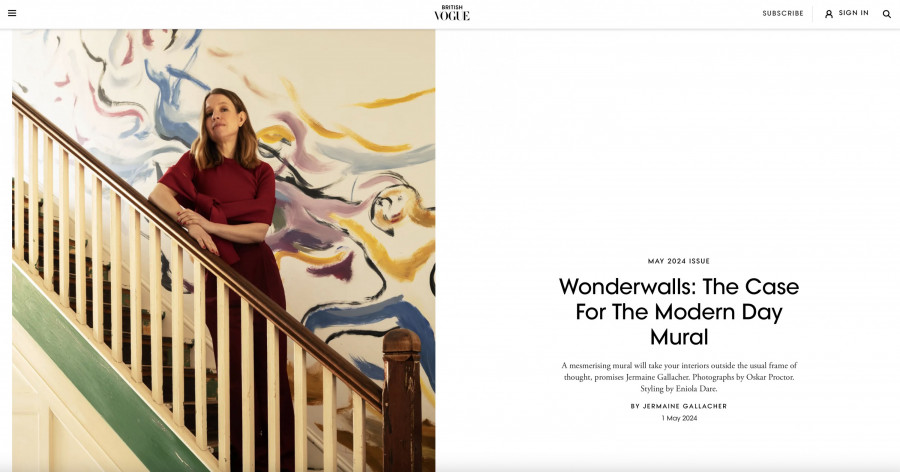
Wonderwalls: The Case For The Modern Day Mural
British Vogue
01.05.2024
Murals aren’t – and shouldn’t – be the preserve of restaurants, shops, runways and opera houses though. I urge you to embrace art and interiors as one and the same, and the Margate home artist Sophie von Hellermann shares with her partner Jonathan Viner and their two children, is a testament to what you can create. As you enter the former early 19th-century convalescence, you are greeted with one of von Hellermann’s distinctive fairy-tale scenes: two dancing figures hand-in-hand ascend the staircase. “I like the architecture of the space to help dictate the work,” von Hellermann explains. Elsewhere, angels hover around stained-glass windows, wizards in wide-brimmed hats sit above doors, bathroom doors swim with mermaids, and kitchen sink tiles are painted with white-cliff scenes of seagulls and a family walking towards the sea.
The German artist is no stranger to such canvases. In Monumental, her recent show at Berlin’s Wentrup gallery, she painted forest scenes and swirling skies directly onto the walls. Another recent von Hellermann’s commission is a 2022 site-specific installation at Schloss Freienwalde – an elegant country house and museum dedicated to Germany’s first and only Jewish foreign minister, Walther Rathenau, where nearly every room is covered in wall paintings. For me, the highlight is in the first-floor salon, where wraparound pink climbing roses make for a heartstopping scene. “I’ll make sure I have as many colours close to hand as possible, and then I like to just go for it,” von Hellermann says. “I like to imagine the people who’ve lived there or been there before. Or think of conversations that took place in those rooms.”
Not Chagall, but want to take the plunge? The trick is to let the architecture of the room be your guide. Doors are a good place to start. Consider them artworks in their own right, or as I call them “canvases on hinges”(I’ve painted the doors in my flat within an inch of their lives). Even the most spontaneous of wall painters – myself included – start with a matt white base. For the mural itself, I prefer to use oil pastels (the viscous kind available at any decent art shop). Personally, I like adding a little turps after to soften things up. You could, of course, always mark out your mural with a pencil first but my advice would be to just go for it. You don’t have to paint a masterpiece – simple and expressive mark-making can be just as effective. To seal your mural, use a matt decorators varnish.